Super User
Mammoet Minimizes Downtime for Gas-Fired Power Station Maintenance Project
The first time an exhaust silencer replacement was lifted in a single piece
Mammoet has completed the replacement of a matured exhaust silencer for a gas turbine, at a gas-fired power station in Victoria, Australia. Removal of this 305t exhaust silencer was completed in a single lift. Therefore, this reduced the amount of time our client, an Australian energy company needed for their operations to be suspended to allow replacement to take place.
There were several challenges on site, which included the space available, how to interface with other activity crucial to the lift procedure, and the technical complexity of the lift itself - which needed to be very precise, despite the weights involved. The challenge lay in creating a methodology that was both strong enough to lift the loads and fast enough to keep delays to a minimum.
So, the lift was meticulously planned, as every aspect of the lift was engineered weeks in advance. The crane’s position, boom laydown and location of the superlift tray were all marked out ahead of its arrival on site, ensuring engineering checks could be made that significantly optimized its setup time.
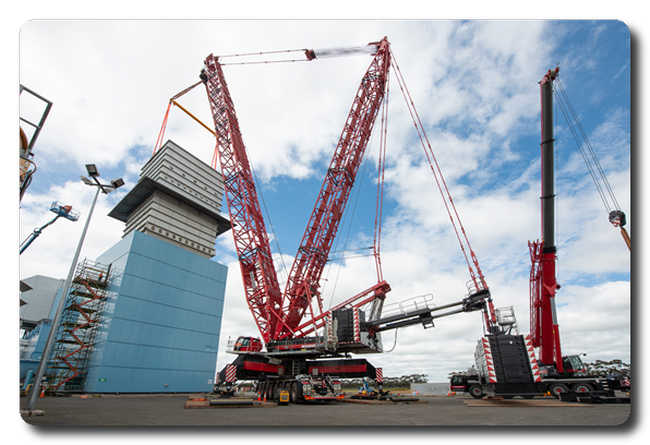 Minimizing the delay for adjusting the crane’s counterweight with auxillary cranes allowed the team to execute the project both efficiently and meticulously.
Minimizing the delay for adjusting the crane’s counterweight with auxillary cranes allowed the team to execute the project both efficiently and meticulously.
Mammoet proposed to use the Liebherr LG1750, because its suspended ballast system allowed the center 125t ballast tray to be disconnected from the outer 400t capacity ballast tray, once the load had been raised to the installation radius. This cut down on any delay so that the crane’s counterweight could be adjusted by auxiliary cranes and allowed the team to execute the project both efficiently and meticulously.
Secondly, the team faced the challenge of having to deal with the gas turbine’s tight shutdown schedule. Mechanical preparations could not start until the gas turbine was switched off and there was a narrow timeframe to complete lifting lug welding, so that the LG1750 crane could be assembled and be ready for lifting.
Mammoet overcame the above challenge by carrying out detailed site surveys in advance and planning an accelerated mobilization schedule. The LG1750 could then be brought onto site and set up quickly to minimize the required shut down period for the gas power plant.
Once the 205t used silencer had been removed, a new silencer was be fitted, comprising two pieces: a 168t base module and a 159t top module.
Throughout the project, Mammoet ensured the highest levels of operational efficiency, so that disruptions to day-to-day work were minimal, and that downtime for the power station was kept low. Furthermore, Mammoet was able to provide right equipment and expertise to efficiently setup and operate the LG1750 SX despite significant space restrictions on-site.
Completion of this replacement will see the gas-fired power station continue with full operation for power generation. The power station’s two generating turbines have an overall capacity of 566 Megawatts.
Mammoet
Mammoet helps clients improve construction efficiency and optimize the uptime of plants and installations. For that purpose, Mammoet offers solutions for lifting, transporting, installing and decommissioning large and heavy structures in the petrochemical, offshore, power, and civil industries. We believe our business is about time: uptime, turnaround time and time to market. To our customers, time is the currency that matters most. That’s why we strive to bring their deadlines forward. It’s an integrated daily effort, shared by everyone at Mammoet, in every aspect of our services: creative engineering, careful planning and safe delivery. For more information, visit www.mammoet.com.
Carbon Neutral Energy Appoints Top Tier Team to Lead US Operation
Carbon Neutral Energy (CNE) has attracted a top tier team to set up and grow its US business.
The hybrid power company, which recently announced its expansion into the American market, has appointed Michael Dumas as Chairman and Stuart Nelson as Chief Executive Officer of CNE (USA).
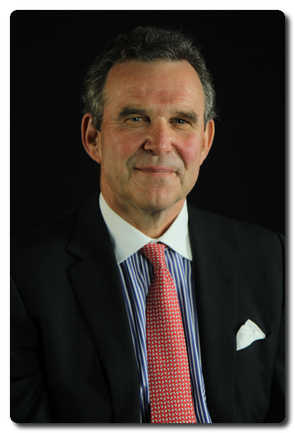 Michael DumasCNE is fast-tracking its overseas expansion due to the huge demand for energy storage systems to add capacity and stability to the electrical grid and prevent emergencies like the loss of power in Texas earlier this year.
Michael DumasCNE is fast-tracking its overseas expansion due to the huge demand for energy storage systems to add capacity and stability to the electrical grid and prevent emergencies like the loss of power in Texas earlier this year.
The company has developed a revolutionary solution to the rapidly growing challenge of storing and using electricity produced from renewable sources. Using a range of mobile, modular battery energy storage systems, CNE aims to increase green electrification and reduce carbon emissions, accelerating the world’s net-zero ambition.
With a depth of international shipping and maritime expertise, Mr. Dumas joins CNE (USA) from Maritime Holdings where he was President and Chief Executive Officer. Michael also held the role of Chief Financial Officer for Intermarine, which specializes in marine heavylift and project cargo. His career has spanned corporate finance and business development with Freeport McMoRan Copper and Gold, including acting as liaison head for Rio Tinto Minera, S.A. in Madrid, Spain.
Formerly President of Cameron International’s Flow Control Division, Mr. Nelson takes up the role of Chief Executive. With extensive experience in leading manufacturing, sales and service of multiple product lines for the energy industry, Nelson managed Cameron’s Drilling Pressure Control products as Vice President and General Manager. He has lived and worked internationally in Singapore, Kuala Lumpur, Jakarta, United Kingdom, USA and Abu Dhabi.
CNE Chairman and interim CEO, Mark Patterson, said: “With the huge opportunity ahead, the ground-work already carried out by the UK team in the last 18 months and the appointments of Michael and Stuart, CNE is well placed to capitalise on the massive market opportunity across the US for our products. We are thrilled to have attracted two high calibre executives with the expert knowledge, drive and the enthusiasm needed to make the most of the opportunity in America.” Mr Patterson will also take an active role on the CNE (USA) board and will be a significant shareholder in the new entity.
Commenting on their appointments, Nelson said: “We are impressed with the CNE UK team’s commitment and drive to develop and grow this opportunity. US industrial users are ready to leverage the benefits of large capacity mobile battery storage and we are excited about capitalising on the potential for CNE’s innovative range of products. We are planning to manufacture here in Texas and are exploring various facilities as well as how we will further strengthen the management team going forward. Personally, I’m very excited to be working with the Patterson family whom I’ve known and respected for many years.”
CNE, a fast-growing hybrid power company, has embarked on a £300 million fund raise and has developed a range of large capacity, mobile battery energy storage systems which can store and deliver significant green power capacity to address inadequacy in power infrastructure.
CNE’s eGen range offers large capacity battery storage from 1MW to 5MW in the form of a mobile unit with a suite of smaller static modules that can be combined to create large energy storage and customised to meet any size of power requirements at any location, potentially creating gigawatt storage systems. This meets demand for mobile power storage with no unnecessary pollution in this era of electrification.
CNE (US) will be based in One Riverway Suite #1700, 777 Post Oak Blvd Houston, TX 77056. More information can be found at www.carbonneutralenergyltd.com
New partnership and innovative approach to support safe energy operations in the Industry 4.0 era
Supporting safe and sustainable energy operations through increasing predictability in safety, production time and quality, are at the forefront of a new collaborative agreement, announced today by the global engineering and technology consultancy, Vysus Group.
- Collaboration will reduce the continuous need for highly specialised, difficult, and time-consuming workshops, producing more targeted analysis
- Game-changing software will disrupt traditional approach to hazard and operability studies (HAZOP)
- AI digital twin technology presents root-causes, consequences and safeguards to mitigate hazards and operating issues
Software and consulting provider Kairos Technology has joined forces with Vysus Group, to develop its intelligent tool that enhances hazard and operability studies (HAZOP).
Kairos Technology’s HAZOP Assistant is a model-based software used during such studies on complex infrastructure. It employs deterministic modelling of a plant, combined with artificial intelligence, to produce a more targeted and comprehensive analysis than is possible with a typical HAZOP.
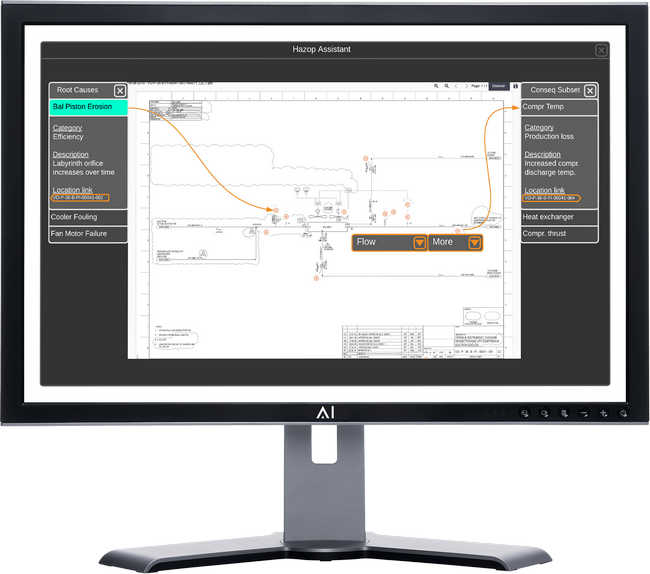
As part of its portfolio of services spanning the energy lifecycle, Vysus Group delivers a range of risk management and risk analysis capabilities. By working together, the expert domain and process knowledge of Vysus Group is combined with the unique explainable artificial intelligence (AI) software from Kairos, ensuring more targeted and comprehensive analysis.
Robert Nyiredy, VP Risk Management with Vysus Group, said: “It’s no secret that potentially dangerous and hazardous factors, such as flammable and explosive materials and equipment, are widely used in the energy sector. In the complex production process system, it is therefore essential to not only avoid design mistakes, but also to be able to predict the cause of process alarms during operations.
“As a safety assessment method that can identify and analyse risk in the operation process, HAZOPs are widely used in the petrochemical industry. HAZOPs rely on the technical experience of the consultant, incorporating lessons learned and utilising a lot of human resources and time.
“The Kairos software solution supports and extends the traditional HAZOP. It reduces the need for highly specialised, difficult, and time-consuming workshops, producing a more targeted analysis. The intelligent digital twin, which incorporates the complete complex process facility, will empower subject matter experts to identify potential hazards and operability problems.
At the same time, it digitally verifies any calculations or assessments made by the experts. The explainable AI digital twin will present instant analysis of root-causes, consequences and safeguards when given a guide word.”
Bjarne André Asheim, CEO of Kairos Technology, said: “The collaboration with Vysus Group will see our software disrupt the HAZOP process. Our ultimate goal is to integrate the insights gleaned from the HAZOP into daily operations, ensuring it is at the fingertips of the operators, and always updated and relevant. Our goal is to capture and continually utilise the knowledge obtained from HAZOPS, ensuring that it is refined during operations, across disciplines, assets and sectors.”
About Vysus Group
Following a strategic-carve out from Lloyd’s Register (LR), LR’s Energy business is now Vysus Group, a standalone engineering and technical consultancy, offering specialist asset performance, risk management and project management expertise across complex industrial assets, energy assets (oil and gas, nuclear, renewables), the energy transition and rail infrastructure.
Vysus Group retains LR Energy’s entire capability and continues to offer its full suite of technical, regulatory, and operational expertise globally, with all 650+ of our global experts transitioning to the new company. Driven by its purpose to help clients manage risk and maximise performance, Vysus Group blends deep technical knowledge and data-driven insights with hands-on expertise.
Working on complex and large-scale energy projects around the world, Vysus Group is one of the leading engineering consultancy partners of choice. Vysus Group launched its new brand in April 2021, with a new logo, brand identity and website reflecting our evolution, value proposition and full spectrum of capabilities.
For more information, visit www.vysusgroup.com.
About Kairos Technology
Kairos Technology, formerly Eldor Technology, was founded in Stavanger, in 2014 by Bjarne André Asheim. Kairos Technology is a software company passionate about creating new insights to benefit plant operations.
Based on the theories on Multilevel Flow Modelling (MFM), a theory invented by Morten Lind, (Professor Emeritus, Senior Researcher) a long-term relationship with the Technical University of Denmark (DTU) was established. Kairos soon established another cooperation with DHRTC (Danish Hydrocarbon Research and Technology Centre) for the research and development of the Kairos products.
Kairos Technology Aps was founded in 2018 in Lyngby, Denmark by Claus Myllerup to further strengthen and develop this relationship.
In June 2019 a milestone was reached when Proventure and Skagerak Maturo made an investment in Kairos Technology, providing a strong foundation for further development and growth.
For more information, visit www.kairostech.no
Metso Outotec to deliver state-of-the-art Premier™ and Vertimill® mills to gold mines in Liberia and Burkina Faso
The Turkish conglomerate Mapa Group has awarded Metso Outotec a contract for the delivery of key grinding technology to their gold mine expansions in Liberia and Burkina Faso. The value of the order is approximately EUR 19 million, and it has been booked in Minerals Q2/2021 orders received.
“Mapa is a major conglomerate working in various industrial and construction sectors. For us, good support, reliable project execution, and sustainable equipment and process performance are essential. Alongside the existing good relationship between the companies, they’re the reasons why we selected Metso Outotec for these projects,” explains Mustafa Bülent Karaarslan, COO, Mapa Group.
Metso Outotec will deliver identical grinding lines to both sites, consisting of state-of-the-art Premier™ ball mills and energy-efficient Vertimill® VTM-3000 stirred mills, each line featuring a capacity of 400tph. The deliveries are expected to take place in January 2022.
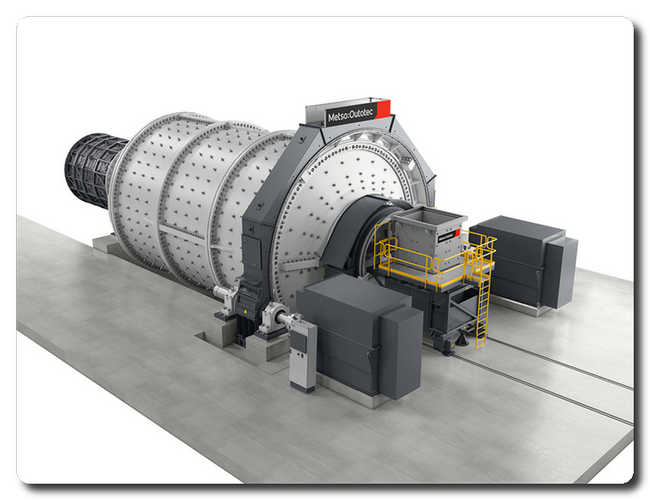 Metso Outotec Premier Ball mill
Metso Outotec Premier Ball mill
“We are excited that Mapa has chosen us to deliver the key equipment for the expansion of these two projects in Liberia and Burkina Faso. Previously, we have delivered the key crushing, screening and grinding equipment to these two mines,” says Mert Katkay, Head of Minerals Sales for Metso Outotec in the Middle East and Turkey.
Discover more about Metso Outotec grinding technology and Planet Positive approach.
Metso Outotec is a frontrunner in sustainable technologies, end-to-end solutions and services for the aggregates, minerals processing and metals refining industries globally. By improving our customers’ energy and water efficiency, increasing their productivity, and reducing environmental risks with our product and process expertise, we are the partner for positive change.
Metso Outotec is committed to limiting global warming to 1.5°C with Science Based Targets. We ranked 8th on the 2021 Global 100 list of the world’s most sustainable companies.
Headquartered in Helsinki, Finland, Metso Outotec employs over 15,000 people in more than 50 countries and its sales for 2020 were about EUR 3.9 billion. The company is listed on the Nasdaq Helsinki. mogroup.com
New Fluke ii910 Precision Acoustic Imager detects electrical discharge
Teams operate more safely and pinpoint air, gas and vacuum leaks with greater sensitivity.
The new Fluke™ ii910 Precision Acoustic Imager uniquely enables the detection of corona and partial discharge from a safe distance of up to 120 meters. Teams can operate safely, minimise the risk of fires and help reduce outages. The Fluke™ ii910 also offers greater sensitivity to detect compressed air, gas, and vacuum system leaks, reducing downtime which can cost up to EUR 1000,- per minute.
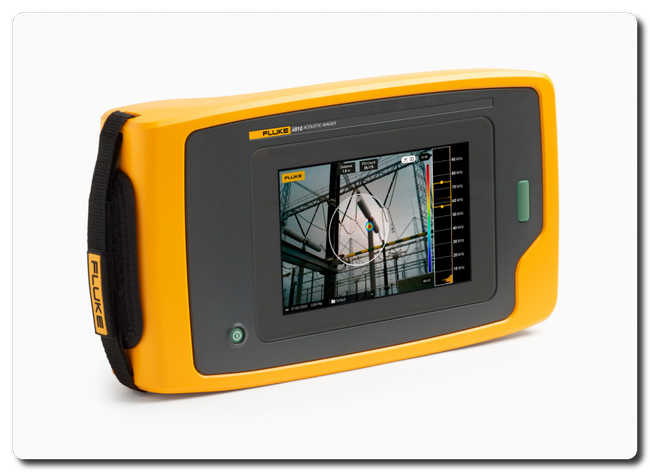
Regular routines – no training required
Electrical discharge detection or leak checking can be carried out as part of a regular maintenance routine. The handheld imager enables users to quickly, and visually, pinpoint the location of faults from a safe distance and record data for later analysis. Even small, low-pressure or low-density leaks are now detected easily. The rugged ii910’s intuitive operation means no training is required – it is simple to learn and easy to use. The straightforward, intuitive interface allows technicians to isolate the sound frequency of the leak and filter out background noise in even the noisiest environments.
Fast and visual leak and discharge detection
The rugged, handheld casing of the Fluke ii910 has a seven-inch LCD touchscreen which overlays a SoundMap™ on a visual image for rapid identification of discharge or leaks between frequencies of 2-100 kHZ. The array of integral microphones converts ultrasound signals into clear visual images on the backlit touchscreen. Captured data can be transferred via an integral USB-C socket directly to a PC. From here, the data can be uploaded to the Machine Learning PDQ Mode™ Reporting Platform. This will provide the most important partial discharge insights, including partial discharge type identification. The ii910 provides video recording of up to 5 minutes and has a battery life of at least 6 hours.
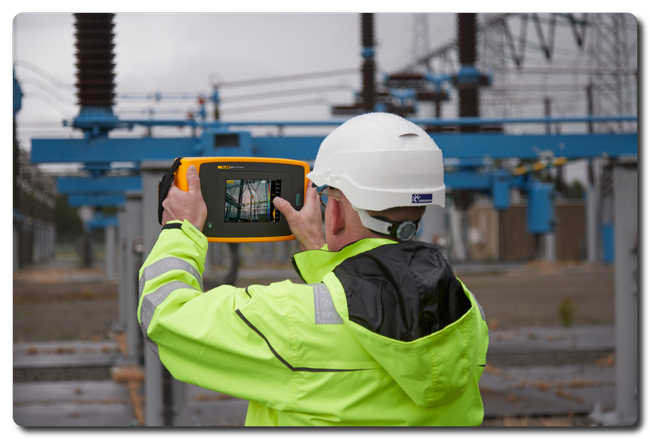
Power generation, production or maintenance added value
Fluke’s innovative SoundSight™ technology now enables corona and partial discharge to be easily located. For technicians working with high voltages in power generation and transmission and with industrial high voltage equipment, the Fluke ii910 provides more sophisticated detection than standard ultrasonic tools while offering the visual performance of more expensive UV cameras. It detects, locates and provides visual reporting and severity assessment of corona and partial discharges. Technicians in production locations can isolate the sound frequency of the leak and filter out background noise in even the noisiest environments. Industrial maintenance technicians can identify leaks at a safe distance considerably faster than using traditional diagnostic methods, even during peak production periods.
For more information about the new Fluke ii910 Precision Industrial Imager, please visit www.fluke.com
About Fluke:
Fluke’s mission is to be the world leader in compact, professional electronic test tools. The company’s products are used by technicians and engineers in service, installation, maintenance, manufacturing test, and quality functions in a variety of industries throughout the world. Founded in 1948, Fluke has offices in 13 European countries and distributes its products to over 100 countries around the globe. The company’s European revenues contribute approximately 40 per cent of worldwide sales. Fluke’s headquarters are located in Everett, Washington State and the company employs over 2,500 people internationally. Its European sales and service headquarters are located in Eindhoven, The Netherlands.
FLUKE is a registered trademark of Fluke Corporation. For more information, visit the Fluke website at http://www.fluke.com
AEG Power Solutions Supplying Power to H-TEC Electrolysers at Haurup Wind Power Site
AEG Power Solutions, a global provider of power supply systems and solutions for industrial, critical infrastructure and innovative power electronic applications announced that H-TEC SYSTEMS has chosen AEG PS power package solution for the hydrogen production plant built at Haurup in Schleswig-Holstein by the renewable energy company “Energie des Nordens” (EdN).
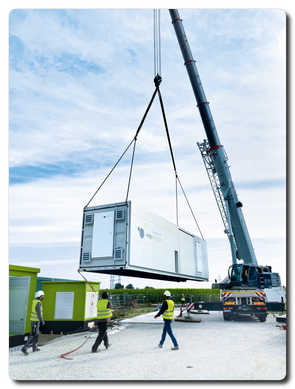 The project was implemented to optimize local wind energy production. A lot of excess wind power is generated at this grid node. By implementing the electrolyser, every kilowatt produced can be used instead of switching off the wind turbines. The newly developed system with a nominal output of one megawatt is to feed up to three million kilowatt hours from excess wind power as hydrogen annually into the gas network. The plant contributes to the supply of around 20,000 proWindgas customers of Greenpeace Energy, main shareholder of EdN. It is also supporting the stabilization of the grid. The renewable gas can be stored in the existing gas network and converted back into electricity in flexible gas-fired power plants anywhere in Germany, if required.
The project was implemented to optimize local wind energy production. A lot of excess wind power is generated at this grid node. By implementing the electrolyser, every kilowatt produced can be used instead of switching off the wind turbines. The newly developed system with a nominal output of one megawatt is to feed up to three million kilowatt hours from excess wind power as hydrogen annually into the gas network. The plant contributes to the supply of around 20,000 proWindgas customers of Greenpeace Energy, main shareholder of EdN. It is also supporting the stabilization of the grid. The renewable gas can be stored in the existing gas network and converted back into electricity in flexible gas-fired power plants anywhere in Germany, if required.
H-TEC SYSTEMS is equipping the plant with an ME 450/1400 PEM electrolyser. The company is a technology leader in in the manufacturing of PEM (Proton Exchange Membrane) electrolysers for the production of green hydrogen. The company supplies the high-tech electrolysers of the project as a turnkey solution integrated into containers. These compact solutions can be implemented anywhere—directly at wind and solar parks, at filling stations, or in industrial plants.
To supply power to its modular and flexibly deployable electrolysers H-TEC SYSTEMS chose Thyrobox DC 3 systems also for their flexibility and high efficiency.
The Thyrobox DC 3 was designed to provide good power factor and minimized harmonics even at part loads, which contribute to energy efficiency and limited distortions to the grid feeder, and finally reduce the overall cost of operations of such processes as electrolysis.
“H-TEC SYSTEMS containerized electrolysis process is very innovative and cost efficient”, explains Andreas Becker, Head of Grid & Storage business at AEG Power Solutions.”Our concept of flexible power supply modules matches closely this approach and we are very proud to be part of the project at Haurup which is a very good example of how to optimize wind power generation through green hydrogen production.”
About AEG Power Solutions
AEG Power Solutions ensures continuous power availability and the safe operation of critical applications thanks to with a wide portfolio of power supply systems and services: AC and DC UPS, battery chargers, rectifier systems, service and maintenance on 24/7 basis, as well as fully customized UPS systems to customer specifications.
AEG Power Solutions has developed a distinctive expertise and world-class engineering capacities that bridge both AC and DC power technologies and span conventional and renewable energy platforms. AEG Power Solutions has decades of experience with UPS and power electronics, and grid integration, and is leveraging its conversion expertise to engineer and deliver solutions for energy storage applications.
AEG Power Solutions is the sole subsidiary of the holding company 3W Power.
For more information, visit www.aegps.com.
Eficode acquires Contribyte to strengthen its Agile transformation services
Acquisition further expands strategic advice available for software organizations
Eficode, Europe's leading DevOps company, has today announced the acquisition of Contribyte, a leading provider of Agile and product development coaching and training.
Software development organizations adopt DevOps and Agile practices to create a competitive advantage from software. The rapid expansion of software in all industries has fuelled the need for coaching and training around tools, processes, and culture. With the acquisition of Contribyte, Eficode reinforces its ability to help organizations transform to Agile and DevOps practices and implement effective software development tools.
"Eficode sees Contribyte as the leading coach for ambitious software organizations in Agile transformation. We will offer Contribyte's deep expertise to our customers all over Europe to build winning product and software organizations.", says Ilari Nurmi, CEO of Eficode.

By acquiring Contribyte, Eficode further expands customer relationships at a strategic level, accelerating Agile and DevOps practices and the adoption of cloud computing. The acquisition enables accelerated growth of consulting and coaching around DevOps and Sustainable Software Development. It also accelerates the adoption of the Eficode ROOT DevOps platform: a managed service on the cloud that spans the entire software development lifecycle, from requirements management to Continuous Delivery and analytics.
"We are delighted to join Eficode. Contribyte has deep expertise in helping organizations become more agile. We advise and coach our customers through strategic changes, to gain a competitive advantage from software. Our customers have requested services from us that are at Eficode's core. Joining Eficode enables us to offer them a broader set of skills and services, and solve their broader challenges.", says Henri Hämäläinen, CEO of Contribyte.
Contribyte has over 300 customers in and outside Europe, from banking, industrial manufacturing, and business services.These include ABB, Vaisala, Nokia, CRF - now Signant health, Helvar, and DNA. Contribyte's revenue was 3,8 million euros in the last financial year.
About Eficode
Eficode is the leading DevOps company in Europe, driving the DevOps and Agile movement and building the future of software development across seven countries, with over 400 professionals.
Eficode guides customers with DevOps and Agile skills and practices, and enables them to focus on their growth and customers with Eficode ROOT DevOps platform: a managed service with over 40 preferred tools including Atlassian, Jenkins and Kubernetes, along with their Application Management and Atlassian services.
About Contribyte
Contribyte is the coach of winning product organizations and teams of the future. They help organizations become better in product development.
Contribyte trains key product people, designs winning organizations, and helps these get more value out of the tools. Contribyte’s coaches have years of experience in improving product development practices and product creation processes.
Securing OT systems against cyber-attack
With Smart Manufacturing continuing to merge the worlds of information technology (IT) and operational technology (OT), the demand for comprehensive security measures to protect OT networks is growing. For a standards-based approach, stakeholders can turn to the IEC 62443 guidelines.
David Bean, Solutions Manager at Mitsubishi Electric, looks at the fundamental aspects that need to be considered, including suitable system level design, risk management, system intrusion detection and automation platform vulnerability management.
As the technologies to bridge the divide between the worlds of IT and OT within a plant have become more established, the digitalisation of businesses has accelerated. The goal of this digital transformation is to provide a foundation to boost productivity, optimise asset availability and maximise plant utilisation. That foundation is built upon a rapidly growing network of increasingly sophisticated plant floor devices – the so-called Industrial Internet of Things (IIoT).
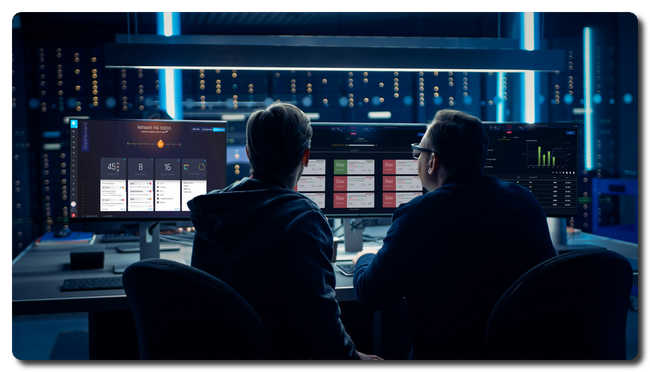 Mitsubishi Electric delivers solutions to help businesses protect their OT networks.
Mitsubishi Electric delivers solutions to help businesses protect their OT networks.
Addressing cyber security
However, this greater level of integration brings with it an increased onus to consider and improve cyber security. Figures from the Centre for Economics and Business Research (Cebr) and gov.uk (1) estimate the cost to UK businesses of cyber breaches in excess of £18bn. From a general manufacturing perspective cyber-attack brings the risk of lost production, theft of intellectual property and the negative impact on brand confidence as well as potential environmental damage if safety systems are affected. It is perhaps, then, not a surprise to find that, according to a Make UK report (2), the threat of cyber-attacks is stopping some 35% of manufacturers from investing in digitalisation.
Further, from the perspective of safety critical infrastructure, asset owners also have to consider the potential cost of being found to be non-compliant with the Network and Information Systems (NIS) Directive. In the UK, the maximum penalty for a breach of the NIS Directive is £17m, enough to give even the biggest businesses pause to think.
Implementing cyber security standards
With all of that said, though, the risk of not investing in digital transformation is enormous, particularly in this era of global competition. From an OT perspective, there are now established standards that provide all of the stakeholders in a deployed industrial automation system – the asset owners, the system designers/integrators and the individual product vendors – with the tools and guidelines that they need to secure an installation against cyber-attack.
Chief among these is IEC 62443, which provides a systematic and practical approach to cyber security for plant OT systems, covering every aspect from initial risk assessment right through to operations. It defines the differing security roles of the key stakeholders, specifying the unique requirements for each security level within the control ecosystem.
IEC 62443 reinforces the accepted ‘defence in depth’ strategy, defining methodologies for implementing OT cyber security measures and outlining procedures as well as policies that can form the methods, for firstly hindering an attack and secondly recovering from an attack.
It is notable that IEC 62443 places some considerable onus on the automation equipment supplier to embed protective features within their products to contribute to system design considerations and lifecycle management, as well as respond to any vulnerabilities that may be discovered.
 Mitsubishi Electric’s products have long offered a number of security features that support the development of a robust cyber security strategy.
Mitsubishi Electric’s products have long offered a number of security features that support the development of a robust cyber security strategy.
Defence in depth
This is something Mitsubishi Electric takes very seriously. The company’s products have long offered a number of security features that support the development of a robust cyber security strategy. The ‘defence in depth’ approach that it adopts when advising systems integrators and asset owners on the methodologies that should be used to implement secure networks and control systems are closely aligned with IEC 62443.
In addition, Mitsubishi Electric has established a Product Security Incident Response Team (PSIRT) as defined in IEC 62443. Further, Mitsubishi Electric offers a risk audit service that helps asset owners understand the risks in terms of criticality and consequence of a potential cyber breach. The service provides a written report on the status of the networked industrial control systems and offers recommendations for any remediation that is required to meet the standards set out in IEC 62443.
Most recently, Mitsubishi Electric has built a collaboration with Radiflow, whose intrusion detection and analytical tools for generating risk reports and remediation measures meet all the requirements of IEC 62443. These tools can provide ongoing passive status monitoring of networked assets, highlighting any associated vulnerabilities – for example in access control methods – and flagging up any suspicious network traffic.
Evolving cyber threat
In essence, an OT cyber security solution is an insurance policy and as with so many things in life, the more comprehensive the policy, the greater the level of protection. Implementing a robust solution is part of a successful digital transformation strategy and ensures that companies can boost productivity and enhance their competitiveness.
Mitsubishi Electric strives to help businesses leverage state-of-the-art industrial automation solutions within a secure framework, while also providing a single point of contact to create smart manufacturing solutions with secure OT networks. All of this provides the foundation for a strong security platform for industrial automation systems, in accordance with IEC 62443 and meeting the requirements of the NIS Directive.
References:
(1) https://assets.publishing.service.gov.uk/government/uploads/system/uploads/attachment_data/file/674046/understanding-costs-of-cyber-crime-horr96.pdf
(2) https://www.makeuk.org/insights/blogs/manufacturers-agree-they-need-more-cyber-security-support
About Mitsubishi Electric
With 100 years of experience in providing reliable, high-quality products, Mitsubishi Electric Corporation (TOKYO: 6503) is a recognized world leader in the manufacture, marketing and sales of electrical and electronic equipment used in information processing and communications, space development and satellite communications, consumer electronics, industrial technology, energy, transportation and building equipment. Embracing the spirit of its corporate statement, Changes for the Better, and its environmental statement, Eco Changes, Mitsubishi Electric endeavors to be a global, leading green company, enriching society with technology. The company recorded consolidated group sales of 37.8 billion dollars* in the fiscal year that ended on March 31, 2021.
Mitsubishi Electric Europe, Industrial Automation – UK Branch is located in Hatfield, United Kingdom. It is a part of the European Factory Automation Business Group based in Ratingen, Germany which in turn is part of Mitsubishi Electric Europe B.V., a wholly owned subsidiary of Mitsubishi Electric Corporation, Japan.
The role of Industrial Automation – UK Branch is to manage sales, service and support across its network of local branches and distributors throughout the United Kingdom.
ECOLAB LAUNCHES DIGITAL SOLUTION FOR FOOD AND BEVERAGE PRODUCTION THAT OPTIMIZES WATER USAGE AND REDUCES OPERATING COSTS
Ecolab Inc., the global leader in water, hygiene and infection prevention solutions and services, launched Water Flow Intelligence, a digital service that provides industry with real-time visibility of water usage at the enterprise, site and asset levels.
Water Flow Intelligence enables food and beverage producers to identify opportunities that help improve water management across their operations, deliver on sustainability goals and reduce operational costs by combining smart water meters and sensors with advanced water flow measurement and monitoring, asset performance insights and machine learning.
“Water Flow Intelligence uses cutting-edge digital technologies to enable real-time insights and response,” said Pedro Sancha, senior vice president and general manager of Ecolab’s Industrial Digital business. “By gaining visibility to water use across their organizations, companies can optimize their operations and make real progress on their water-related sustainability goals, from the enterprise level to individual facilities.”
The service is powered by ECOLAB3D™, a secure, cloud-based digital platform that translates data from multiple sources into actionable insights. ECOLAB3D uses advanced algorithms and predictive analytics to power better business outcomes, enhancing the value and impact Ecolab delivers to businesses through its programs, products and services.
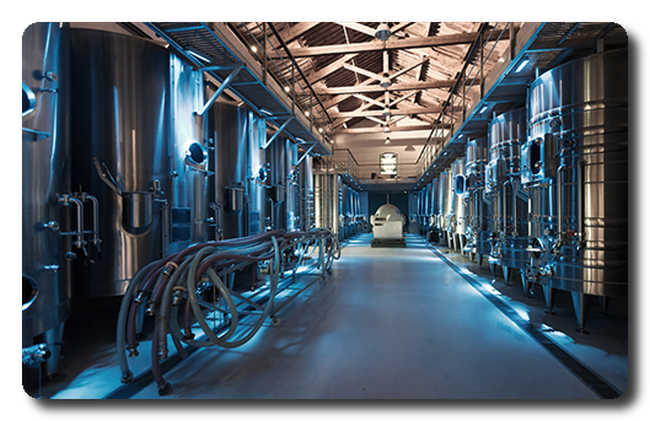 Ecolab’s new service, Water Flow Intelligence, uses IoT and predictive analytics to improve sustainability, ensure product quality, minimize water risk and optimize its use.
Ecolab’s new service, Water Flow Intelligence, uses IoT and predictive analytics to improve sustainability, ensure product quality, minimize water risk and optimize its use.
Manual data collection and analysis to track water use is often tedious, resource-intensive and difficult to execute consistently across sites. Through the data and insights provided by Water Flow Intelligence, developed by Nalco Water, Ecolab’s water management business, users can efficiently pinpoint on a user-friendly dashboard where water is being consumed across the connected assets and processes within their facilities, set enterprise-wide benchmarks and strategically target improvement efforts to help maximize water savings.
At the local plant level, Water Flow Intelligence helps users protect their facilities against water damage and excess water use – which can negatively impact the local community and result in costly fines. Through the combination of real-time monitoring, advanced alarm notifications and 24/7 oversight by engineers at Ecolab’s System Assurance Center, the service alerts users to out-of-spec conditions as they occur, enabling faster responses to address leaks and other issues.
In addition to managing risks, Water Flow Intelligence can help reduce costs by reducing water use. After it was installed in the pretreatment area of a North American auto manufacturing assembly plant, it cut water use at the facility by 15%, saving 25 million gallons of water and $193,000 per year.
“Paired with the knowledge and expertise of our on-the-ground sales and service teams, Water Flow Intelligence can help businesses gauge the effectiveness of their water management plans and improve their water footprint,” said Darrell Brown, executive vice president and president of Ecolab’s Global Industrial group. “This is more important than ever as the gap between freshwater availability and demand continues to grow, and companies worldwide step up their sustainability commitments to build resilience and drive action in the face of both climate change and water scarcity.”
The launch of this new service comes at a time when rising industrial water use continues to contribute to the world’s growing water stress and scarcity challenges. According to the World Resources Institute, the world will experience a 56% freshwater shortfall by 2030 if nothing changes, an increase from the 40% shortfall projected by the U.N. in 2015. At the same time, S&P Global reports that corporate water use progress is currently insufficient to prevent the projected freshwater gap.
Water Flow Intelligence is currently available to industrial businesses in North America and Europe, with expansion to Australia and New Zealand by the end of 2021. To learn more, go to ecolab.com/waterflowintelligence
Beautiful Bull Shoals and the wastewater treatment plant just a stone’s throw away…
We all love it when a plan comes together….
In July 1952 in Arkansas, when President Harry S. Truman dedicated the Bull Shoals dam on the White River, which created Bull Shoals Lake, it, as planned, brought about a boom in tourism – and how.
Perhaps not even the man who said that ‘America was built on courage, on imagination and an unbeatable determination to do the job at hand’ could have envisioned that today, according to The Arkansas Game and Fish Commission, Bull Shoals’ fishery is worth (annually) an astonishing $705M. And when taking into consideration all the other visitor spending factors such as food, lodging and transportation, that figure rises to an incredible $1.5B each year for Arkansas. The largest lake in The Natural State, with 45,440 acres of water and a 1,000-mile shoreline, Bull Shoals Lake stretches along Arkansas's northern border and into southern Missouri.
Ranked in the Top 5 trout fisheries in the world, the pristine welcoming waters of the White River sit just a stone’s throw away from …….the water and wastewater treatment plant (WWTP) at Bull Shoals.
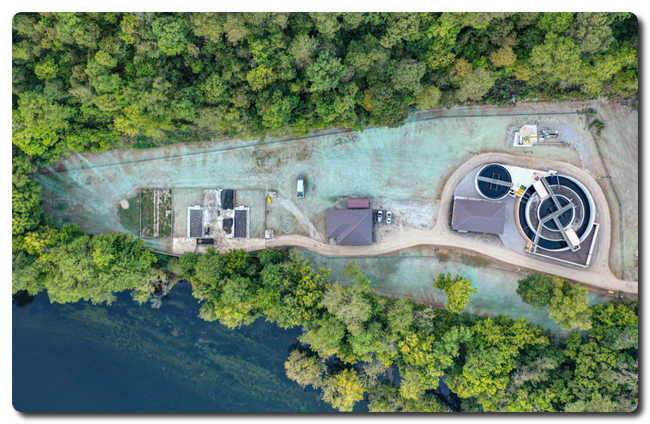
‘Blend in with the local landscape’
Described by Dr David Nixon, the Mayor of Bull Shoals as ‘technologically sophisticated and aesthetically pleasing’, the recently upgraded plant has been very carefully designed to blend in with the local landscape – but for the due diligence and sheer hard work of keeping the old plant (designed for 20 years – but still running after 40) -
in safe working order, the operators of Bull Shoals’ WWTP deserve the highest possible praise for protecting such a hugely important area.
Built in 1976, the original above-ground steel plant, just 30 yards from the precious White River, had, towards the end of its life, begun to resemble more of a rusty patchwork quilt. For all the continuous repatching, reworking and rebuilding, the plant presenting a possibility of failure would have been disastrous.
‘A failure would have been truly devastating’
“Our ecology here is wonderful,” said Bull Shoals’ Mayor, David Nixon. “It is vital that we protect it. A failure would have been truly devastating for the local and regional economy, for who knows how long.”
He added: “We knew we’d reached the time where we had to really push for some funding to bring in a new, modern treatment system – but it is such a credit to Jim Chorba, our Public Works Director, that despite the age and condition of the old plant, it was still giving out great samples. Nursing all that equipment to keep it running; he is a treasure to the City.”
Before any bidding process could begin for a brand-new wastewater treatment facility, The City of Bull Shoals needed to know at the very earliest stage what sort of costs would be involved, so that it could determine what its targets would be for funding.
‘We needed a truly first-class facility’
Mayor David Nixon said: “We knew one thing for certain that here, where our water is the intrinsic element to the wellbeing of so many people, we needed a truly first-class facility. We also needed an upgraded collection system for our sewer system, which has 19 lift stations.”
Independent consulting engineer Mike Marlar P.E. was brought in initially to lend his considerable experience as to what would be the best investment for Bull Shoals.
“After years of managing a very old plant to prevent an escape of raw water, this was a tremendous opportunity to work with the City on a new wastewater treatment facility that would do justice to its surroundings,” said Marlar.
“The new plant needed to be one structure – concrete, so less prone to corrosion than the old steel plant – and unlike the existing tank, mainly below ground, with more sympathetic lighting – because just across the river is one of the most popular campgrounds in Arkansas.”
He added: “Reliability was a must, yet equipment that was also easy to work with and low on maintenance, with room for future expansion, including tertiary filtration downstream of the clarifier and two aeration tracks for redundancy. As well as eliminating any risks, we also wanted to comfortably exceed state discharge limits.”
The two projects - the wastewater treatment facility and the installation of a new collection system for the city’s sewer system were to cost $9.5M (This cost included building a new plant on a tight site, while keeping the old plant running, and then site clearing the old plant).
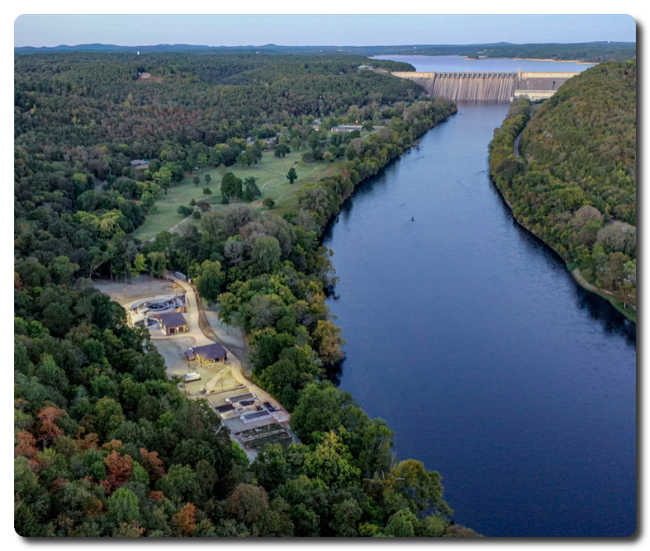
Mayor David Nixon continued: “We aimed high, but we were confident to tell our engineers and designers to give us their very best. Of course, things took time with funding, but the close proximity of the plant to the White River and its huge importance to the economy meant that we saw generous support from multiple federal agencies.”
In May 2017, voters in Bull Shoals approved a 1-percent sales tax to repay a $3.5M loan awarded to the city by the U.S. Department of Agriculture’s Rural Development division to help fund the new plant. That sales tax will expire as soon as the city repays the loan.
Bull Shoals also received three grants to help construct the wastewater facility:
- $4M from U.S. Department of Agriculture
- $1.4M from the Northwest Arkansas Economic Development District
- $500,000 from the Delta Regional Authority.
After much deliberation, homework and recommendations, the City of Bull Shoals chose to invest in an E.A. Aerotor Plant, which quite unlike typical small package plants, incorporates all components of a large scale, extended aeration/complete mix process in conjunction with final clarification. Made by Illiniois-based Lakeside Equipment Corporation (established 1928), the E.A. Aerotor Plant is custom-designed to provide optimum performance at the lowest possible cost with the Closed Loop Reactor (CLR) and Spiraflo Clarifier tailored to meet the specific requirements of Bull Shoals. To save space and reduce installation costs, the equipment was provided – via Lakeside’s agent in North Little Rock, Shupe & Associates – in a common, circular wall design, with the outer loop utilizing the CLR process for extended aeration, while the inner area incorporates the Spiraflo Clarifier for final settling.
Jim Chobra, the Public Works Director for Bull Shoals, who among his many duties, runs the WWTP, said:
“For a treatment plant, right next to the third largest trout river in the U S, we just couldn’t be in a worse position – right where our effluent goes in, so when it came to the new equipment, we went out to other sites to see and hear first-hand about what was out there. We saw two Lakeside units that caught our eye and heard very good reports from the operators.”
He added: “Deactivating the old plant to get the new one online was quite a challenge, with a tight deadline, but the seeding process was very successful. We had wonderful clear water within 24 hours. It works beautifully.”
Mayor David Nixon agreed: “Some said it would take two months for everything to settle, but we had good water in very quick time, which is credit again to Jim Chorba, as well as Lakeside, and the guidance we had from Mike Marlar. We didn’t skip a beat when switching over from the old plant to the new. The first samples just seven days later were well within compliance.”
Lakeside’s E.A. Aerotor Plant actually provides the same treatment results as a stand-alone Closed Loop Reactor Process. Activated sludge can reside in the reactor basin for up to 24 hours in the extended aeration process, followed by continuous clarification using the Spiraflo Clarifier – removing as much as 96% BOD and Suspended Solids - and provide as much as 99% nitrification.
Mike Marlar continued: “When we went online in May 2020, we were, as Mayor Nixon stated, immediately within compliance. I’ve used Lakeside equipment before and really like how their rotors work – the fact that they have very few moving parts – and that you can easily adjust them to increase or decrease the oxygen transfer. It has very simple ease of operation.”
The rotors that Mike Marlar refers to are the Magna Rotors – a vital component of the Lakeside CLR process. These horizontal, bladed rotor aerators provide oxygen and mixing to the basin, providing greater oxygen transfer than any other mechanical surface aerator. Shaft-mounted drives also allow flexibility for speed changes and easy access for maintenance.
The investment in Lakeside’s equipment also included the Spiraflo Clarifier, which minimizes many of the problems associated with center-feed peripheral take-off clarifier hydraulics, such as the Waterfall Effect, which is totally eliminated.
Bull Shoals benefits too now from a Raptor Fine Screen, which combines four processes in one unit (screening, washing, compacting and dewatering). Captured screenings are washed free of most organics to approximately 40 percent solids. Volume is reduced by 50 percent and weight by 67 percent, thereby reducing disposal cost. And to remove inorganic grit from the new treatment plant in a mechanically induced vortex environment, there is the SpiraGrit, which has rotating paddles that maintain the flow velocity in the vortex chamber, keeping organics in suspension while allowing heavier grit to settle on the chamber floor. The settled grit moves across the floor and falls into the lower grit hopper.
For Public Works Director, Jim Chorba, who is one of a team of just two for the plant, his 15-plus years of protecting Bull Shoals continues.
“We are watched closely and heavily at this plant and that’s fine with me”, he says. “I’m a stickler, who likes keeping everything in order, including records. Previously, when we had no redundancy in the old plant, we had to hustle. I won’t miss that. I’m just pleased that the financers understood the magnitude of what we have here and why it is so important. This Lakeside plant works very well.”
‘We chose right with Lakeside’
Mayor David Nixon concluded: “Overall, we now have an outstanding plant. When we show it to visitors, we don’t expect them to say it, but they comment on how lovely it is! – and they’re right. It’s a tribute to all the work in the design phase that the new plant blends into the point that people aren’t aware of it. It doesn’t even make any noise like the old plant did, so it improves the experience for people enjoying all the many great outdoor activities that people love at Bull Shoals. Even the lighting design means that we have plenty for safe work, but again without being intrusive to the local environment. We chose right with Lakeside and know what a good investment the plant is for the long term. Compared to what we had before, we all sleep much better these days.”
